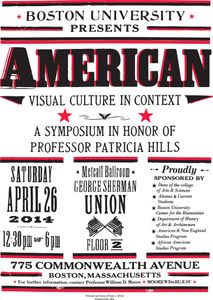 On a rainy Saturday afternoon toward the end of Patricia Hills’ last semester at Boston University, her colleagues, peers, and students gathered together to celebrate her distinguished career. A symposium that included the presentation of papers by former students, as well as celebrations by colleagues and friends, it was a fitting sendoff for someone who we all expect will continue to have a valued presence both here on campus as well as in the field.
On a rainy Saturday afternoon toward the end of Patricia Hills’ last semester at Boston University, her colleagues, peers, and students gathered together to celebrate her distinguished career. A symposium that included the presentation of papers by former students, as well as celebrations by colleagues and friends, it was a fitting sendoff for someone who we all expect will continue to have a valued presence both here on campus as well as in the field.
Sponsored by the Dean of the College of Arts & Sciences, Alumni & Current Students, the Boston University Humanities Center, the Department of the History of Art & Architecture, the American & New England Studies Program, and the African American Studies Program, the event demonstrates how many students and departments Professor Hills influenced while here at Boston University.
Again and again, celebrants and former students alike praised Hills not only for her scholarship and contributions to the field, but also for her dedication to her teaching. She was called friend, mentor, colleague, supporter, and beloved matriarch—so many roles that have been bestowed upon her over her near-forty year career. Her many articles, books and museum work, including her work on Eastman Johnson, Alice Neel, Jacob Lawrence, the social realists of the 1930s, and others, remain an invaluable contribution to historians of American Art.
Allison Blakely, director of the African American Studies Program summed up the many kind things said about Professor Hills in his remarks. “In reflecting over what it is that has inspired Pat’s tireless professional efforts,” he said, “a description of Jacob Lawrence she gives in the preface of her most recent book on him caught my eye. She wrote: ‘Lawrence was one of the gentlest artists we knew, but was also one of the toughest! I admired him not only for his art, but also because he never swerved from his commitment to the struggle for a fair and just society’ I think here is a case of the eyes of an art historian recognizing in an artist a fine reflection of herself!”
If there can be any single image that highlights Professor Hills’ dedication to teaching, it is this: throughout the entire symposium she sat in the front row, dutifully scribbling down notes to share with her former students. Not simply content to sit back at a celebration of her career and a presentation of all the fruits of her academic tutelage, she remained the teacher, supporter, and mentor. We know that will continue for many years to come.
-Rob Ribera
Hello, your article content is very good! It contains a lot of information which is quiet benificial to us, thankyou for sharing this article with us! cat language translator
This text beautifully captures the essence of Professor Patricia Hills’ impact at Boston University and in the field of American Art history. It highlights not only her scholarly achievements but also her deep commitment to teaching and mentoring. Her legacy is celebrated through the symposium, which brought together her colleagues, peers, and students. The event, filled with praise and gratitude, shows how much she influenced both the academic and personal lives of those who had the privilege of working with her.
DogTranslatorApp 2025